In a month, the first laptops with RTX 50-series GPUs will be released. However, a new leak about the mobile RTX 5080 indicates only moderate leaps, similar to the desktop version.
A little more than a week after the test embargo was lifted and the official launch, the picture around the Nvidia Geforce RTX 5080 is becoming a little clearer.
While the Blackwell GPU is virtually unavailable, the actual performance gain over its predecessors RTX 4080 and RTX 4080 Super is moderate, as we in our test of the RTX 5080 have determined:
- Compared to the RTX 4080, the new Nvidia GPU is around 17 percent faster in terms of raster performance in Full HD resolution, and the RTX 5080 is still around 12 percent faster in terms of raytracing performance. The differences become more and more moderate with higher resolutions.
- The situation is similar in the Full HD comparison to the RTX 4080 Super, which, according to various reviews, lags around eight percent in rasterizing and around seven percent in ray tracing. The differences to higher resolutions turn out to be in similar spheres.
Any existing hopes that Nvidia Blackwell can at least make a significant leap over RTX 40 in the mobile sector are now being dampened further in a new leak.
RTX 5080 Laptop: First TimeSpy benchmark can only achieve limited success
As the portal Videocardz, citing the Chinese portal bilibili, reported, a score in the popular “Time Spy” course in 3DMark has appeared here.
- According to this, the laptop version of the RTX 5080 should achieve a GPU score of 21,948 points. This would make Nvidia’s new mobile GPU around 16 percent faster than its direct predecessor, which achieves an average of around 19,000 points.
- The leaked value may even be beaten by an RTX 4080M: the highest measured TimeSpy value of such a GPU is 22,105 points.
However, it is unclear under what conditions the RTX 5080M was tested. In the screenshots provided on Bilibili, the power consumption is missing, which, according to Nvidia, can be between 80 and 150 watts.
The CPU score of 10,627 points given here at least indicates this TDP: the values are most similar to those of the Asus ROG Zephyrus G16, which is equipped with an Intel Core Ultra 9 185H and achieves an average of around 10,950 points.
- This laptop basically limits the GPU to TDPs between 105 and 125 watts; a turbo mode can unlock an additional 15 watts. So it is conceivable that there is still some room for improvement for the RTX 5080M.
- It should also be noted that Time Spy is a classic synthetic benchmark. We will find out in March, when the Blackwell laptops hit the shelves, whether the gaming performance can continue to set itself apart, especially when DLSS 4 is taken into account.


